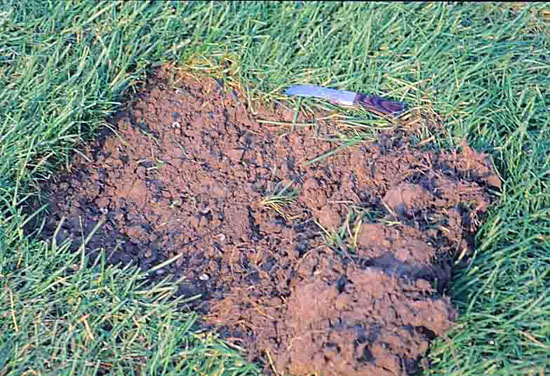Issue 12, August 11, 2014
Japanese Beetle
Populations of adult Japanese beetle continue to be light in most of Illinois. Although leaf feeding damage on linden, crabapple, rose, and other trees and shrubs is obvious in some areas, the amount of damage is less than in most years and not as widespread.
The reduced number of adult beetles should translate into fewer eggs laid in turf. The combination of fewer eggs resulting in fewer white grubs and continued timely rainfalls in most of Illinois should result in less white grub injury to turfgrass this year. However, there are spotty areas of drought in Illinois this summer so turf managers in those areas should be more watchful for white grubs and their damage.
Now is the time to be scouting for white grubs throughout the state. The eggs have hatched so there are grubs to find, but they will be too small until mid to late August to eat enough roots to cause dieback.

White grub scouting.
Cut through the turf with a sturdy knife, I like to use a folding outdoor knife. Select an area where white grubs have been previously, areas that are damper, or the edges of brownish areas. Cut about a one-foot square on three sides, and pull back the sod. In moist soil, the white grubs will be obvious on the soil surface where they have been feeding on the roots of the grass. Look for grubs hanging onto the underside of the sod, and till the upper three inches or so of the soil with the knife blade to flip any deeper grubs onto the soil surface. In dry soil, the grubs will descend downward to where the moisture is located, so they are likely to be four to six inches deep.
Ten to twelve grubs per square foot are enough to cause damage. Heavily used turf, is damaged by fewer grubs, about eight grubs per square foot. Lightly used turf can have fourteen or more grubs per square foot without showing dieback. Even one to three grubs per square foot are attractive enough to raccoons, skunks, and insectivorous birds to result in digging damage.
High grub numbers can still be reduced to non-damaging levels with an application of trichlorfon (Dylox) or chlorantroniliprole (Acelepryn). Imidacloprid (Merit), thiamethoxam (Meridian), and clothianidin (Arena) are also effective, but the grubs may not die for two to three weeks. All grub insecticides provide better control if watered in with at least one-half inch of water. (Phil Nixon)
Author:
Phil Nixon